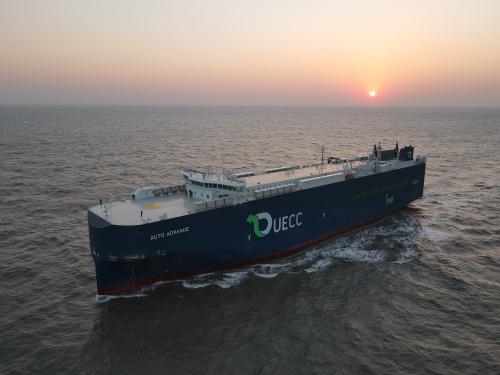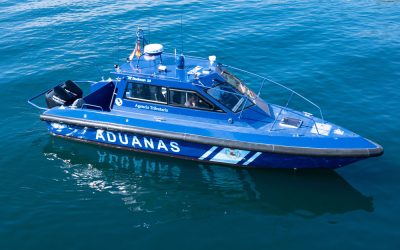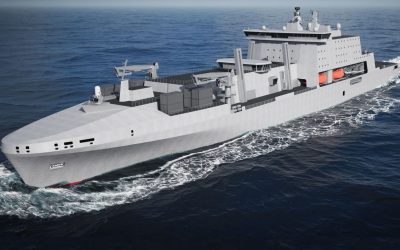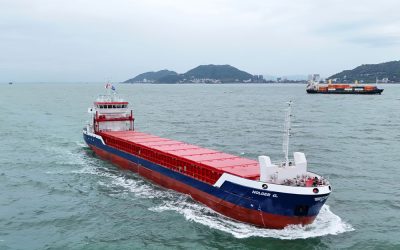United European Car Carriers (UECC) broke new ground for the pure car truck carrier (PCTC) segment in 2016 when it took delivery of the first LNG-fuelled PCTCs, the ‘E-Class’ Auto Energy and Auto Eco, built at Cosco’s Nantong Zhongyuan Chuanqi Shipping Engineering Co.
The Norwegian-based shortsea ro-ro operator (which is jointly owned by NYK LIne and Wallenius Lines) returned to China once again for the world’s first dual-fuel LNG battery hybrid solution, Auto Advance, which was delivered by Jiangnan Shipyard in November 2021, with two sister ships due to follow this year.
Designed specifically for UECC by Jiangnan’s in-house ship designer Shanghai Merchant Ship Design & Research Institute (SDARI), Auto Advance is said to deliver significant gains in energy efficiency and emissions reduction.
Auto Advance will predominantly operate on a regional route between northern Europe and the Mediterranean. Built as an oceangoing single-screw, dual-fuel diesel engine driven flexible PCTC, it’s suitable for carrying rolling cargo such as cars, trucks, buses and other vehicles, as well as dangerous and hazardous cargoes.
The vessel has an erect stem, a bow thruster, transom stern and full spade rudder with bulb. Total effective car deck area including ramps is about 30,600m2, giving it capacity for 3,580 Corona RT43-L standard units spread across 10 car decks, including two electric operated hoistable decks and eight fixed decks which are connected by movable and fixed ramps. Its cargo hold is divided into four gastight/watertight compartments, equipped with a low-pressure CO2 fire extinguishing system.
Auto Advance incorporates an S-bow, a kind of erect invisibility bulb-bow and lower wind resistance superstructure, designed and developed by SDARI. Hull lines were optimised in operational profile at 16.0knots and 17.8knots on 8.30m draught, while optimum trim tests were conducted at two draughts, two speeds and four trims.
The controllable pitch propeller at combined mode, the optimal rotate speed and pitch are automatically matched to improve the propulsion efficiency. The daily fuel oil consumption of the main engine is 29.1t/day at service speed, and fuel gas consumption 23.5 t/day. Its cruising range at 16.0knots using LNG will be about 3,500nm and using low-sulphur MGO about 4,000nm at design draught 7.70m.
Combined with this dual-fuel engine technology is an energy storage system (ESS) supplied by Finnish company WE Tech, incorporating a battery package from Corvus Energy, that can be charged by a permanent magnet, directly driven shaft generator or the dual-fuelled generators. The 510kWh capacity NCM lithium-ion batteries, which have been awarded the Battery Safety notation by classification society DNV, can be charged at sea using the shaft generator, allowing them to be at full strength when deploying the bow thrusters for port manoeuvring.
According to UECC, the use of LNG will cut emissions of CO2 by around 25%, SOx and particulate matter by 90% and NOx by 85%, while the vessel will also meet the IMO’s Tier III NOx emissions limitations for the North Sea and Baltic Sea. The attained EEDI score of 16.661 g-CO2/ (tonnes per nm) against a required (Phase 2) score of 18.146 g-CO2/(t.nm), ensures Auto Advance meets IMO’s requirements for a 40% reduction in carbon intensity by 2030.
PRINCIPAL PARTICULARS
Length overall: 169.10m
LPD: 164.50m
Moulded breadth: 28.0m
Moulded depth: 13.08m (main deck); 29.12m (upper deck)
Design draught: 7.70m
Gross tonnage: 35,667gt
Deadweight tonnage: 8,222.9dwt
Total loading car capacity: 3,580 (RT43)
Main engine: WinGD 6RT-flex50DF
Complement: 10 officers, 10 crew
Classification society: DNV
Flag registry: Portugal




